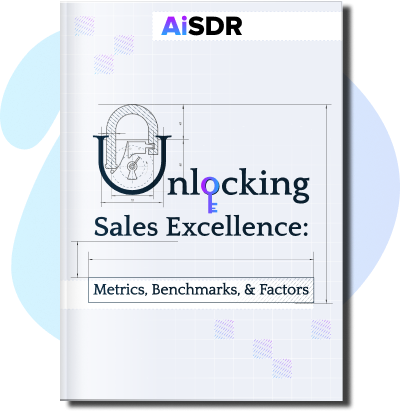How to Build a Sales Persona for AI Software

Get best practices for building a sales persona into an AI prompt
Adding an AI SDR to your team is just like hiring any other team member.
The catch? While you can simply toss your sales playbook at a brand-new SDR and tell them to read it, the same won’t work for AI SDRs.
Instead, you’ll need to convert your playbook into a sales persona for your virtual SDR.
What is a sales persona for AI?
Think of a sales persona as a profile of someone on your sales team. The sales persona can represent a completely fictional person, or you can base it on someone in your company, such as the CEO, founder, or head of sales.
For smaller companies and start-ups, one well-crafted sales persona might be enough to handle the majority of communication. If you structure your prompt the right way, all you need to do is swap the target audience to quickly scale campaigns without creating more personas.
However, bigger organizations will likely create multiple personas for different roles, such as a sales development rep, a business development manager, and potentially even the company’s CEO.
What makes these personas special is that they’re not just profiles. They also tell the AI how to speak with leads.
Sales personas frequently cover:
- Demographics: Who is the persona supposed to be (age, job, industry)?
- Motivations and goals: What are they trying to achieve?
- Target audience: Who is the persona speaking with?
- Audience challenges: What problems are they trying to solve and how?
- Communication style: How should the persona chat with leads? Are they friendly, formal, or somewhere in between? Do they joke?
- Sales approach: What strategies and tactics do they use to get meetings booked and handle objections?
How to prepare for building a sales persona for AI
Outreach tools like AiSDR use sales personas to speak with leads like your real sales reps would. A well-defined sales persona ensures AI won’t just fire off generic responses. Instead, the AI will speak in a way that resonates with each unique prospect.
Before building your sales persona, there are a few important steps to lay the groundwork.
Collect lead data
To build a sales persona that really understands your leads, you have to start by learning everything about them.
Here’s where you can find the necessary information:
- Internal sources: Tap into your CRM data, sales records, and customer feedback for valuable insights. Remember to review customer “lookalikes” and notes from sales demos to get the full picture.
- External sources: Complement your internal data with external research. Market research reports, surveys, and competitor analysis can provide additional context.
Plenty of tools exist to help you collect and analyze this data, from CRM platforms like HubSpot to survey tools like SurveyMonkey.
Identify your target audience
Once you’ve gathered your data, it’s time to analyze it and identify who your AI sales persona will be talking to. The more specific you get, the better your AI tool will perform.
Here’s what you should look into:
- Demographics: Who are your customers? Details like age, gender, education level, and income can shape your buyer persona.
- Firmographics: Consider where they’re working. What’s their company size, industry, location, etc.? Ideally, it should match your ideal customer profile (and if it doesn’t, you might want to update your ICP).
- Psychographics: What motivates your customers? Understanding their values, interests, and lifestyles can help you tailor your approach.
- Behavioral data: How do your leads behave at different buyer journey stages? Look at past purchases, product usage, and engagement patterns to understand their buying journey.
Describe your AI sales rep’s personality
What’s your AI sales rep’s personality, communication style, and knowledge? Is it friendly and casual or professional and to the point?
Generally, it’s best to adjust these according to your target audience.
And when you add email examples to your persona, make sure to adjust their tone to fit the personality. Otherwise, this might throw off the AI.
Outline how the AI fits your sales process
Your AI will need to handle many different scenarios and classify email responses so it knows how to respond.
You’ll also want to create a list of common questions and objections, and then write out responses that address lead concerns.
Unfortunately, you won’t be able to include more than 5-8 of these, so you’ll want to specify what the AI should do if it runs into an unscripted scenario, whether it’s referring the lead to someone else or flagging the question for someone’s attention.
Turning a sales persona into an AI prompt
After you’ve collected this information, it’s time to build it into a prompt that AI can use.
Here are some tips to help you build a good sales persona prompt.
Be clear and specific
Ambiguous or overly complex language is a common sales persona mistake that leads to less-than-ideal results.
You’ll want to keep your prompt clear and to the point.
- Good example: “Define CEOs about 3 ways AI SDRs support sales outreach.”
- Bad example 1: “Pros of AI SDRs.”
- Bad example 2: “Go over 3 beneficial advantages of employing AI SDRs for the purposes of increasing revenue for start-ups in the tech B2B SaaS industry.”
The good example has just enough information (e.g. task, target audience, goal) that the AI should be able to produce something useful.
As for the bad examples, the first is too vague and “pros” could be understood – Does it refer to benefits or professionals? The second is confusing, redundant, and overly long, and AI is unlikely to produce something usable.
Use simple language
AI works best with simple, direct language. You should avoid jargon or overly technical terms as much as possible, and when you do need to include them, you should define them.
- Good example: “Explain how AI SDRs help small businesses improve sales outreach.”
- Bad example: “Analyze the impact of applying machine learning algorithms and large language models to optimizing sales pipeline efficiency of SMBs.”
Simple instructions allow AI to consistently produce results.
Give context
Providing context helps AI understand the scenario it’s operating in. The more relevant background information you include, the better your AI sales rep can tailor its responses. Even if you’ve already set up most of the details about the sales persona, adding context almost always helps, especially information about your pricing model and plans.
For instance, if you have several sales personas, make sure to specify how the AI should act in each case:
- “You are a sales development representative contacting CEOs at tech startups with 1-10 employees.”
- “You are a senior account executive contacting CIOs at large enterprises with 500+ employees.”
- “You are a sales development representative reaching out to CTOs at tech startups with 1-50 employees.”
Define the desired outcome
Tell AI exactly what you want. If your goal is to schedule a meeting or get a positive response from a lead, say it.
- Good example: “Write an initial email to a cold lead. Your goal is to get them to visit your pricing page.”
- Bad example: “Generate a cold email.”
AI is hyper-focused on completing its task, and telling AI what you expect helps it do that.
Add examples of good outputs
Giving examples of successful emails is a good way to teach your AI how to write emails that convert leads to demo. Whether it’s cold emails, follow-up messages, or product pitches, providing 3-5 effective examples will provide a path for AI to deliver its best responses.
Add guardrails
Set clear boundaries to keep AI on track. This might include a word count limit, words to avoid, and any tones you shouldn’t use.
For example, you might mention that emails should be shorter than 50 words, avoid words like “delve”, and make subject lines concise.
This prevents AI from going off-script.











